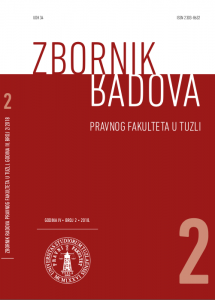Definicije počinitelja ratnog nasilja i žrtve: sociološka analiza nasilja u koncentracijskim logorima za vrijeme rata u Bosni i Hercegovini
Definitions of the Perpetrator of War Violence and the Victim: Sociological Analysis of Violence in Concentration Camp During the War in Bosnia and Herzegovina
Author(s): Goran BašićSubject(s): Military history, Political history, Criminology, Studies in violence and power, Victimology, Transformation Period (1990 - 2010), Inter-Ethnic Relations, Politics and Identity, Identity of Collectives, Peace and Conflict Studies
Published by: Pravni fakultet Univerziteta u Tuzli
Keywords: genocide; alien criminal; extermination; systematized war violence; organized war violence; verbal emphasis; collective identity; ethnic identity; ethnonational identity;
Summary/Abstract: This article analyzes the experiences retold by former concentration camp detainees who were placed in concentration camps like civilians at the beginning of the Bosnian war in the 1990s. The article aims to analyze the narratives of war violence in concentration camp as well as identifying how the perpetrators of war violence and victims are symbolically defined in stories. In these descriptions, the perpetrator is defined as a dangerous, evil, and ideal enemy. He is portrayed as a real and powerful yet alien criminal. When informants emphasize extermination and the systematization of war violence in the camps during the war, they produce and reproduce the image of violence that is organized and conducted on a daily basis. The aim of this verbal emphasis seems to be that the described acts of violence in the camps, after the war obtain the status of an organized war violence - genocide. By defining the perpetrators of war violence, the interviewed in the study implicitly point out the complementary opposition of the perpetrator - a victim of violence. The victim is presented as pre-war acquaintance, friends and neighbors of the perpetrators of violence. Victim of violence is defined as tired, dying in agony, inferior, de-humanized, stamped and helplessly left to the mercy of the perpetrators of war violence. Leading people to only one primary (deadly) collective identity exists at every place where the “ethnic identity” of people is considered more important than their personal, individual, civic, professional human identity. The merging of ethnonational identities into a completely homogeneous, massive, unique collective identity, which is substantially or (totally) different from some others – perfectly matches reproduction and the creation of new forms of violence.
Journal: Zbornik radova Pravnog fakulteta u Tuzli
- Issue Year: 4/2018
- Issue No: 2
- Page Range: 44-73
- Page Count: 30
- Language: Bosnian

